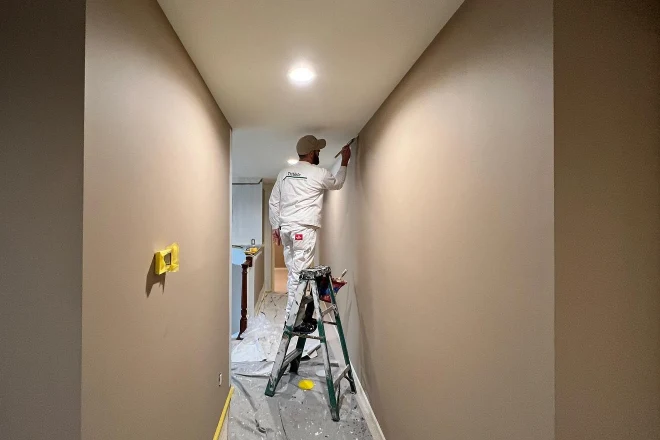Key Points
- Latex paint requires 2–4 hours of drying time between coats, while oil-based paint needs a full 24 hours. Primer typically needs 1–2 hours, but always check the label for brand-specific guidance.
- Waiting the proper time between coats prevents common issues like paint peeling, streaks, and poor adhesion. Applying a second coat too soon can trap moisture and lead to long-term durability problems.
- To tell if your paint is ready for another coat, use touch, visual, and scent cues. The surface should feel dry and smooth, show no glossy patches, and no longer smell strongly of wet paint.
Coat Check: Don’t Let Timing Ruin Your Paint Job
Ever rushed through a paint project only to end up with peeling, streaks, or uneven color?
Wondering why some walls look perfectly smooth while others seem off—no matter how many coats you apply?
In this post, you’ll learn exactly how long to wait between coats of paint based on the type of paint, finish, and other conditions like temperature and humidity.
We’ll also break down how drying really works, what happens if you don’t wait long enough, and how to tell when your wall is actually ready for the next coat.
By the end, you’ll have all the timing tricks you need to get smooth, durable interior home painting results that look great and last.
Ready to skip the guesswork?
Give Tribble Painting Company a call or fill out the contact form—we’ve got the timing (and the technique) down to a science.
How Long to Wait Between Coats of Paint?
If you’re painting in Ann Arbor or any of the surrounding towns, the wait between coats can vary depending on the paint type you’re using.
Skipping this step or rushing it can lead to problems like paint peeling or an uneven finish.
Here’s a fast breakdown to help you stay on track:
- Latex paint (water-based paint):
- Recoat time: 2 to 4 hours
- Great for interior walls because it dries quickly and has lower fumes.
- Oil based paint:
- Recoat time: 24 hours
- These paints dry slower but offer excellent durability, especially on trim or cabinetry.
- Primer:
- Recoat time: 1 to 2 hours, but always double-check the label since brands vary.
Important tip: Even if your wall feels dry to the touch, it may not be ready for the second coat. Always go by the recommended paint recoat time on the product label—especially during Michigan’s humid seasons.
Understanding Paint Drying vs. Curing
Getting a smooth, lasting paint job means understanding the difference between when paint feels dry and when it’s actually ready for the next coat or fully cured.
Here’s a simple breakdown:
Dry to the Touch
- The wet paint on the surface is no longer sticky.
- Doesn’t mean it’s ready for a second coat or that the paint will adhere properly.
Recoat Time
- This is the safe window when you can apply the next coat without lifting or damaging the first coat.
- Varies by paint type, paint thickness, and drying time conditions.
Cure Time
- This is when the paint fully hardens—known as the paint cure time.
- For latex paint, full cure time can take up to 21 days.
- For oil-based paints, it may take up to 31 days to fully cure.
Even though you may apply two coats in one day, your final coat won’t reach full strength for a few weeks, so go easy on freshly painted interior walls and avoid cleaning them too soon.
Recommended Wait Times by Paint Type

Different paint types come with their own drying behaviors—and ignoring them can mess up your paint job fast.
Whether you’re working with latex paint on your interior walls or oil-based paint on cabinetry, timing is everything.
Here’s a clear breakdown to help Ann Arbor homeowners plan the right recoat time for a smooth, lasting finish:
Latex (Water-Based) Paint
- Dry to touch: ~1 hour
- Recoat time: 2–4 hours
- Paint cure time: Up to 21 days
- Ideal for most interior painting projects, including living rooms and bedrooms. Water-based latex paint is user-friendly and dries quickly in dry, well-ventilated rooms. Follow the link to learn all the pros and cons of latex paint for interior painting projects.
Oil-Based Paint
- Dry to touch: 6–8 hours
- Recoat time: 24 hours
- Cure time: Up to 31 days
- Oil-based paints require more patience but offer great coverage and toughness—perfect for trim, baseboards, and cabinetry in high-traffic areas.
Primer
- Dry to touch: 30 minutes to 1 hour
- Recoat time: 1–2 hours, depending on the brand
- Don’t rush the second coat after priming. Allow enough time for proper adhesion before applying more paint.
Paint Finishes Matter Too
- Flat paint: Recoat in 1–2 hours
- Eggshell or satin: Recoat in 2–4 hours
- Semi-gloss or high gloss: Recoat in 4–6 hours
- The shinier the finish, the longer the paint drying process. Glossy paints tend to need more time between layers to reduce streaks and blotchiness.
Factors That Affect Drying and Recoat Times
Even if you’re using the same paint products, several key factors can impact how long paint takes to dry between paint coats in your home:
Temperature and Humidity
- Ideal drying range: 50°F–85°F with humidity under 50%
- High humidity slows evaporation and may extend your drying time
- Keep this in mind during Michigan summers and rainy spells
Airflow and Ventilation
- A steady flow of fresh air helps paint dry faster
- Open windows or run fans to speed up drying—especially in closed-off rooms
Paint Thickness
- Thicker coats mean slower drying and a risk of sagging or paint peeling
- Apply multiple thin coats of paint instead of one heavy layer
Surface Type
- Porous materials like drywall or plaster walls absorb more paint and may dry faster
- Slick surfaces, like metal or glossy finishes, can slow down the paint drying process
Application Method
- Brushing and using a paint roller lays on more paint than spraying. Follow the link to find out how to choose the best paint roller for your project.
- With spray paint, the first coat is usually thinner and dries faster, but watch out for overspray. Follow the link to view a detailed comparison of spray vs. brush painting.
By adjusting your technique and being mindful of these conditions, you’ll improve paint adhesion, minimize rework, and extend the life of your coats of paint.
Why It’s Important to Wait Between Coats
Whether you’re refreshing a single room or tackling a larger painting project in your Ann Arbor home, one of the biggest mistakes you can make is rushing the recoat time.
Skipping or shortening the wait between paint coats can cause long-term issues that cost more time and money down the line.
Consequences of Rushing the Job
- Peeling or lifting: If you apply the second coat too soon, it may not adhere properly to the first coat, leading to paint peeling or bubbling. Follow the link to discover how to fix peeling paint on the ceiling.
- Uneven finish: Trapped moisture can cause patchy or streaky results, especially with semi-gloss or high-gloss finishes.
- Compromised durability: Paint that hasn’t fully dried may not bond well, meaning your paint job won’t hold up over time.
- Extra costs: Fixing mistakes like flaking or poor coverage often means sanding, priming, and starting over with more paint.
Long-Term Effects to Watch For
- You may need to repaint entire rooms sooner than expected.
- Surfaces may remain tacky for weeks if the second coat is applied too soon.
- In extreme cases, improper layering can prevent your paint color from curing properly, even with high-quality paint.
Waiting the right amount of time ensures each layer settles correctly, giving your coats of paint a chance to last and look their best.
How to Tell If Paint Is Ready for Another Coat

If you’re not sure whether your first coat is ready for another layer, don’t just guess.
The best way to protect your paint job is to use a few simple tests to check for dryness, especially if you’re working in a space with poor ventilation or high humidity.
Quick and Easy Tests
- Touch test: Gently press your fingertip to the surface. If it feels cool or sticky, it’s still wet paint.
- Visual check: Look for a consistent appearance—no shiny or uneven spots.
- Sheen test: If using flat paint, wait until the surface looks matte before applying paint again.
Tactile Clues to Watch
- The wall feels dry and smooth.
- There’s no soft resistance when you gently run a finger over the surface.
- The room smells less like paint—a sign that solvents in oil-based paint or water-based paint have started evaporating.
These simple checks can help ensure the next coat doesn’t ruin the one before it.
In Ann Arbor’s fluctuating weather, it pays to be patient with your drying time.
Manufacturer Instructions Matter
No matter how much painting experience you have or how many painting projects you’ve completed around Ann Arbor, there’s one rule that always holds up: trust the label.
The instructions on your can of paint or primer aren’t just suggestions—they’re specific to the paint type, formulation, and even the ideal recoat time.
Why Following the Label Matters
- Drying time and cure time can vary between brands, even among similar latex paint or oil-based paint options.
- Some high-quality paint lines include additives that change how long it takes for paint coats to dry.
- Product-specific guidance helps avoid common issues like applying the second coat too soon or waiting too long to apply multiple coats.
A Quick Tip for Homeowners
- If you’re unsure, look up the product’s technical data sheet online. It’s usually more detailed than the can and gives clearer timing for your first coat, recoat paint, and final cure.
Reading those fine-print directions can make a big difference in how well your paint job holds up, especially in Michigan’s ever-changing seasons.
Common Myths About Paint Drying
It’s easy to fall for bad advice, especially when you’re trying to speed up your drying time or get an entire room done in a single weekend.
Let’s bust a few myths that can mess up your coats of paint, whether you’re using spray paint, water-based latex paint, or glossy paints.
Myth #1: “It feels dry, so it’s ready.”
- Truth: Surface-level dryness doesn’t mean the layer is cured or safe for a second coat. If the paint dry time isn’t up yet, applying another layer can cause peeling or bubbling.
Myth #2: “You can speed it up with a hairdryer.”
- Truth: Uneven heat creates thicker coats in spots and may cause the paint to crack. Instead, use fans and open windows to bring in fresh air and help the paint dry faster.
Myth #3: “One coat is always enough with the right product.”
- Truth: Even high-quality paint brands such as Benjamin Moore and Sherwin-Williams often need two coats, especially if you’re changing the paint color or working over a textured surface.
Skipping steps might save time in the short term, but it can cost you in touch-ups and do-overs. When in doubt, slow down and follow the facts, not the shortcuts.
Get Flawless Results—The Right Timing, The Right Finish with Tribble Painting Company
Now you know exactly how long to wait between paint coats, why drying time matters, and how to avoid the biggest painting mistakes.
With the right timing, tools, and techniques, you can get smooth, even coverage that actually lasts—no peeling, bubbling, or re-dos.
If you’re ready to skip the guesswork and get professional-quality results, the interior painting experts at Tribble Painting Company are here to help.
Whether you’re working with latex paint, oil-based paint, or specialty finishes, we’ll make sure every coat counts.

